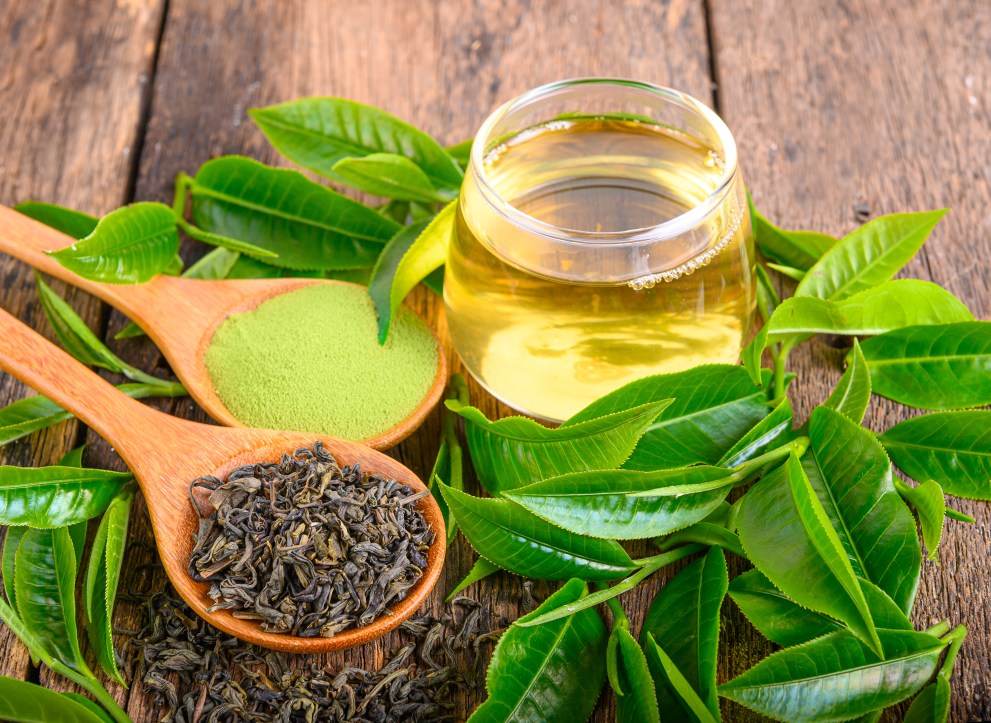At a glance
Green tea is rich in beneficial plant compounds that have long been valued for supporting digestion, steady energy, and overall health. Preparing and timing your tea correctly can help maximize its natural antioxidant benefits.
Green tea is known for its exceptionally high concentration of antioxidants, including catechins, which have been found to help protect cells from damage and reduce inflammation.
While green tea’s gentle caffeine content supports alertness, its health-promoting natural compounds may help contribute to heart and brain wellness.
Let’s look at seven amazing health benefits of green tea and learn how this centuries-old beverage can help sustain energy, focus, and vitality.
What is green tea?
Green tea, a beverage enjoyed for centuries across various cultures, is derived from the Camellia sinensis plant and undergoes a light oxidation process. This means the leaves are exposed to minimal air after harvest, preserving their color, flavor, and beneficial compounds.
Green tea is naturally rich in antioxidants, including catechins, which support cellular functions and may enhance metabolic balance. It also contains mild tannins that contribute to its distinct taste and may help support digestion.
Beyond its soothing qualities, green tea offers a gentle source of caffeine that can enhance alertness without the jitters often associated with excessive coffee intake.
Its light, grassy aroma and smooth texture make green tea a versatile drink enjoyed hot or cold, with or without added herbs or citrus.
Research published by the National Center for Complementary and Integrative Health (NIH) highlights that drinking green tea daily has a wide range of health benefits, including supporting weight management and promoting better metabolic balance.
Watch the video below to discover how green tea supports your health.
Key nutrients and compounds in green tea
Green tea offers many beneficial compounds, including tea polyphenols. These natural antioxidants help protect cells from oxidative stress that can weaken the body’s natural defenses.
Epigallocatechin gallate (EGCG) is among the most bioactive catechins in green tea, which has been linked to many health benefits, including balanced inflammatory pathways, cellular health, and metabolic balance.
While green tea contains only moderate amounts of amino acids and minerals such as potassium and magnesium, regular intake can contribute to its overall nutritional value and complement a balanced diet.
Finally, green tea contains small amounts of chlorophyll, a pigment that gives the leaves their rich green color and may play a role in supporting the body’s natural detoxification processes.

7 health benefits of green tea
Green tea is valued for its light, refreshing taste and rich concentration of antioxidants that help protect cells from damage.
From a reduced risk of heart disease to supporting cognitive function, its potential advantages make green tea a simple yet powerful addition to your daily routine.
Here are seven green tea benefits that can help boost your health.
1. Promotes heart health
The beneficial polyphenols in green tea help maintain the natural flexibility of blood vessels and support healthy blood flow.
These compounds also contribute to balanced cholesterol levels and help maintain vascular tone.
This is supported by a study published in Frontiers in Nutrition, which found that green tea intake helps improve key cardiovascular risk factors, including cholesterol, blood pressure, and blood sugar levels.
2. Supports cognitive function
The natural combination of caffeine and L-theanine offers green tea drinkers steady alertness without overstimulation.
“L-theanine is a naturally occurring amino acid known for its unique ability to promote brainwave activity, fostering a state of mental clarity without causing drowsiness or hyperactivity,” explains Dr. Berg.
This amino acid also offers other potential health benefits, such as reducing inflammation, boosting immune defenses, and promoting cellular repair.
3. Helps maintain healthy blood sugar
Green tea plays a role in supporting stable blood sugar levels by aiding the body’s ability to use energy effectively.
Therefore, consistent green tea consumption may help maintain healthy glucose responses when paired with nutritious meals.
Furthermore, evidence published in the American Journal of Clinical Nutrition found that green tea intake helped lower fasting blood glucose and HbA1c levels, which reflect average blood sugar levels measured over several months.
4. Offers potential anti-aging benefits
Green tea is an exceptional source of antioxidants, particularly catechins and flavonoids, that support the body’s natural defense systems.
These compounds help neutralize harmful free radicals generated during everyday oxidative stress from environmental exposure to pollution, sunlight, and other external impacts that can affect skin health and accelerate signs of aging.
As a result, green tea can help protect cells from harm caused by daily stressors and contribute to a body that is refreshed and resilient.

5. May enhance focus and concentration
Green tea contains a variety of natural compounds, including L-theanine, EGCG, and caffeine, that work together to support relaxation, focus, and mental clarity.
In fact, research published in PLOS One found that drinking green tea helped participants stay alert and reduced feelings of mental fatigue during cognitive tasks.
Therefore, those who regularly enjoy green tea may experience enhanced focus, making it an ideal beverage for supporting concentration throughout the day.
6. Supports weight management
Green tea’s catechins and mild caffeine content encourage fat oxidation and thermogenesis, which is the body’s process of burning calories to produce heat.
These effects may help maintain a healthy body composition when combined with regular exercise and nutritious meals.
In addition, green tea contributes to hydration and sustained focus, helping support an active lifestyle.
7. Promotes healthy digestion
Green tea consumption can help promote digestive wellness through its unique blend of bioactive compounds, including catechins and polyphenols.
These natural compounds work together to support digestive enzyme activity, helping the body break down food efficiently and absorb nutrients more effectively.
Catechins, in particular, also support a balanced gut microbiome, which plays an essential role in digestive health, immune system defenses, and mood regulation.
Meanwhile, the tea’s gentle astringent quality helps soothe the stomach after meals.

How to get the most from green tea
Consuming green tea at least two hours before or after meals helps the body absorb its antioxidants more effectively. This timing also reduces the chance of tannins binding to minerals such as iron, calcium, and folate, which can limit nutrient absorption.
Brewing green tea at around 160 to 180°F (70 to 82°C) preserves its delicate catechins and natural flavor.
What’s more, steeping green tea leaves for two to three minutes allows optimal antioxidant release while preventing excessive bitterness.
To maximize the benefits of green tea, it’s recommended to opt for organic products. This reduces the exposure to pesticides or herbicides that can undermine the health advantages of green tea.
Key takeaways
- Green tea contains powerful antioxidants, including catechins and L-theanine, that work together to support cognitive function and overall metabolic balance.
- Green tea’s health benefits also include supporting heart health, promoting healthy digestion, and aiding in weight management.
- Choosing high-quality organic green tea helps reduce exposure to unwanted additives that can undermine its nutritional value.
- To maximize green tea’s flavor, antioxidant activity, and digestive support, brew at the proper temperature, steep for 2 to 3 minutes, and enjoy it between meals.
FAQ
1. What are the top health benefits of green tea?
Green tea offers numerous health benefits due to its powerful antioxidants that support heart and brain function while promoting focus and balanced energy. Regular green tea intake also contributes to hydration, alertness, and vitality.
2. When is the best time to drink green tea?
The best time to drink green tea is between meals, as it supports hydration and allows antioxidants to be absorbed more efficiently without affecting nutrient intake.
3. Does green tea have caffeine?
Yes, green tea naturally contains caffeine, though in smaller amounts than coffee or black tea. This supports alertness without causing the jittery energy spikes or crashes often linked to higher-caffeine drinks.
4. Is green tea better for you than coffee consumption?
Green tea provides a gentler lift due to its combination of caffeine and L-theanine, which promotes concentration and focus. In contrast, coffee offers a more substantial, faster caffeine boost that helps maintain alertness.
5. Can green tea help with weight loss?
Green tea may support healthy weight management by enhancing fat burning and gently boosting metabolism. Its natural caffeine and catechins work together to help the body use energy more efficiently, especially during exercise.








